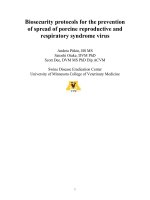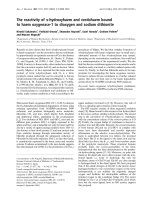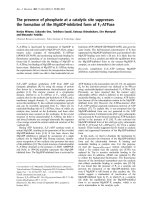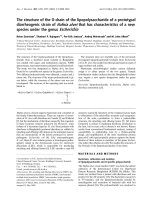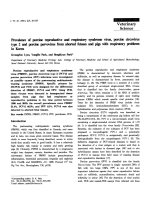Báo cáo y học: " The development of a rapid SYBR one step real-time RT-PCR for detection of porcine reproductive and respiratory syndrome virus" potx
Bạn đang xem bản rút gọn của tài liệu. Xem và tải ngay bản đầy đủ của tài liệu tại đây (519.72 KB, 7 trang )
Tian et al. Virology Journal 2010, 7:90
/>Open Access
SHORT REPORT
BioMed Central
© 2010 Tian et al; licensee BioMed Central Ltd. This is an Open Access article distributed under the terms of the Creative Commons At-
tribution License ( which permits unrestricted use, distribution, and reproduction in any
medium, provided the original work is properly cited.
Short report
The development of a rapid SYBR one step
real-time RT-PCR for detection of porcine
reproductive and respiratory syndrome virus
Hong Tian, JingYan Wu, YouJun Shang, Yan Cheng and XiangTao Liu*
Abstract
Background: Prompt detection of PRRSV in the field samples is important for effective PRRS control, thereby reducing
the potentially serious economic damage which can result from an outbreak. In this study, a rapid SYBR-based, one
step real-time RT-PCR quantitative reverse transcription PCR (qRT-PCR) has been developed for the detection of
porcine reproductive and respiratory syndrome virus (PRRSV). Primers were designed based on the sequence of highly
conservative region of PRRSV N gene.
Results: The sensitivity of the real-time qRT-PCR assay was achieved through PRRSV ch-1a RNA for the generation of a
standard curve. The detection limit of the assay was found to be 9.6 RNA copies per reaction mixture. This assay had
excellent intra- and inter-assay reproducibility as in total 65 field samples were screened for the presence of PRRSV by
conventional RT-PCR in parallel with qRT-PCR, and the detection rate increased from 60.0% to 76.9%. Moreover, the
specificity result indicated that this assay could reliably differentiate PRRSV from the other swine viral diseases, such as
classical swine fever virus (CSFV), swine vesicular disease virus (SVDV) and vesicular exanthema of swine virus (VESV).
Conclusion: The real-time qRT-PCR assay described in this report allows the rapid, specific and sensitive laboratory
detection of PRRSV in field samples.
Background
Porcine reproductive and respiratory syndrome virus
(PRRSV) is a member of the family Arteriviridae [1], and
it was characterized by respiratory disease in young pigs
and severe reproductive failure in sows, including abor-
tion, stillbirths and weak piglets [2]. PRRS has caused
immense economic losses in the pig industry and is con-
sidered to be one of the most important infectious dis-
eases of pigs in the world [3]. PRRSV has been recognized
as one of the most important pathogens of pigs through-
out the world [4]. This virus was first confirmed in China
in 1996, since then, the virus has spread widely in China
[5,6].
Prompt detection of PRRSV in the field samples is
important for effective PRRS control, thereby reducing
the potentially serious economic damage which can
result from an outbreak. Therefore, rapid, specific and
sensitive assays are required for diagnosis of PRRSV in
pigs. Isolation of virus in cell cultures is technically diffi-
cult and time-consuming and thus is not suitable for rou-
tine diagnostic assay. Since 1995, several reverse
transcription-PCR (RT-PCR) methods have been devel-
oped for the rapid and specific detection of PRRSV in
pigs; however, these conventional RT-PCR assays are
labor intensive, as they require gel analysis for the PCR
products, and they are not suitable for high throughput
testing. In contrast, real-time RT-PCR, which completes
amplification and analysis in a closed system, has many
advantages over conventional RT-PCR methods: lower
chance of contamination, allows quantitative measure-
ment of RNA, more rapid to perform and higher sensitiv-
ity.
The aims of this study were to develop a rapid and sen-
sitive method to detect a wide range of field samples of
PRRSV in pigs within a short period of time. In this study,
we used a one step SYBR green real-time RT-PCR
* Correspondence:
1
Key Laboratory of Animal Virology of Ministry of Agriculture, State Key
Laboratory of Veterinary Etiologic Biology, Lanzhou Veterinary Research
Institute, Chinese Academy of Agricultural Sciences, Lanzhou, Gansu730046,
China
Full list of author information is available at the end of the article
Tian et al. Virology Journal 2010, 7:90
/>Page 2 of 7
method to detect and quantify PRRSV from field sam-
ples. The results indicated that this method provide a
new avenue to the rapid detection of PRRSV in one reac-
tion.
Results
Optimization of one step SYBR green real-time RT-PCR
The annealing temperature and the primer concentration
were optimized (Tables 1 and 2) using the RNA extracted
from ch-1a (viral RNA concentration 9.6 × 10
5
copy num-
bers per reaction mixture) as a positive control. The opti-
mal annealing temperature was 56°C, and optimal primer
concentrations were 0.4 μM. The results were analyzed
using MxPro™ QPCR Software and Tm values were taken
to verify the specificities of the PCR products.
Reproducibility of one step SYBR green real-time RT-PCR
In order to evaluate the reproducibility, a dilution end-
point standard curve was made and was repeated for
three times. Ct values were measured in triplicate and
were plotted against the amount of infectious units (Fig.
1). The inter-assay calibration curves in Fig. 1 indicate
that a linear detection range between 9.6 to 9.6 × 10
5
copy
numbers per reaction mixture. The standard formula is y
= -3.528x + 15.60 and the correlation co-efficient is 0.999.
Analytical specificity and sensitivity of one step SYBR green
real-time RT-PCR
PRRSV, CSFV, SVDV and VESV strains from widely dif-
ferent geographical regions were selected for amplifica-
tion in the qRT-PCR assay. We found that specific signal
was found in PRRSV but not in CSFV, SVDV and VESV.
To determine the sensitivity of the one step SYBR green
real-time RT-PCR method, ch-1a RNA were diluted 10-
fold serially from undiluted to10
-6
. The diluted ch-1a was
still positive at 10
-5
dilution (Ct = 38.65), the sensitivity of
this method was 9.6 copy numbers per reaction mixture.
No primer-dimers or non-specific product were found in
negative control (Fig. 2 and Fig. 3).
Comparison of real-time qRT-PCR and conventional RT-PCR
Next, the detection limit of the real-time qRT-PCR assay
and the conventional RT-PCR assay were compared. The
real-time qRT-PCR assay was able to detect a 10
-5
diluted
sample, with a corresponding Ct value of 38.65 ± 0.49
(Fig. 4). In parallel, the analytical sensitivity of the con-
ventional RT-PCR was found to be a 10
-4
dilution (Fig. 5).
These results indicate that the sensitivity of the qRT-PCR
assay was observed to increase one log unit than that of
the conventional RT-PCR assay.
Detection in field specimens
To assess the use of the qRT-PCR for the detection of
viral RNA in the field, 65 samples were collected as
described previously. 39 of these 65 samples were found
to be positive by conventional RT-PCR, and viral RNA
loads were found to be in the range of 10
2
to 10
4
copies
per reaction mixture (2 μl total RNA). Further, qRT-PCR
was performed to all these 65 samples. Surprisingly,
eleven additional samples were identified positive by this
assay (Table 3). These additional samples were confirmed
to be positive by sequence analysis. These data further
confirmed that our method is more sensitive than the tra-
ditional method in the detection of field specimens.
Discussion
Real-time RT-PCR has several advantages over conven-
tional RT-PCR. Firstly, it is more rapid and sensitive. Sec-
ondly, it is performed in a closed one-tube system and
avoids potential cross contamination during sample prep-
aration for post-PCR analysis. Real-time RT-PCR assays
have been widely utilized for early diagnosis of many
other animal viral diseases [7,8]. In this study a one-step
real-time RT-PCR assay was developed and evaluated for
detection of PRRSV in field samples. The assay described
in this report generates complete result within 2 h and
can be used as a rapid diagnostic tool.
To improve the specificity and sensitivity of the method
described it was necessary to optimize the conditions of
primers and annealing temperature. With these parame-
ters, the detection of the ch-1a could be up to a 10
-5
dilu-
tion. This method does not require post-PCR
manipulation, because the melting curve data allow us to
verifying the amplification products diminishing the
Table 1: Annealing temperature of Nf/Nr oligonucleotide
pair optimization by means of Ct values
Annealing temperature Cycle threshold (Ct)
53 23.12
55 22.90
56 21.26
57 23.78
58 25.62
Table 2: Determination of optimized primers concentration
for the PRRSV one step real-time RT-PCR
primers concentration (μM) Cycle threshold (Ct)
0.1 > 40
0.2 37.11
0.3 29.05
0.4 25.60
0.5 25.21
0.6 24.90
Tian et al. Virology Journal 2010, 7:90
/>Page 3 of 7
potential contamination risk. No primer-dimers were
observed in the amplification products when analyzed by
melting curve. Under the conditions mentioned in this
paper, the sensitivity of this method was 9.6 copies per
reaction mixture (Fig. 2). By comparing with conven-
tional RT-PCR, the analytical sensitivity was found to be
a 10
-4
dilution. It is obvious that our method can increase
the sensitivity one log unit than that of the conventional
RT-PCR assay.
Considering the prevalence and economic impact of
PRRSV, a simple, cost effective, sensitive and rapid diag-
nostic technique is very important. The one step SYBR
green real-time RT-PCR assay described in this study has
all these attributes. This technique has tremendous appli-
cations in routine diagnostics in common laboratories.
Conclusion
The one-step real-time RT-PCR assay described in this
report appears to be a simple, sensitive, specific and rapid
method for detection and quantitation of PRRSV in field
samples
Materials and methods
Virus strain and field samples
CH-1a (GenBank access number: AY032626) virus strain,
CSFV, SVDV and VESV were preserved at virology
department of Lanzhou Veterinary Research Institute,
Gansu of P.R.China. 65 field samples were collected from
PRRSV-suspected animals during 2008 in China. Samples
were placed at -70°C for further use.
Table 3: Diagnostic field samples tested positive by real-time qRT-PCR or conventional RT-PCR
Tissue samples Number Conventional
RT-PCR positive
Real-time
qRT-PCR positive
Lung 40 36 39
Lymphoid tissues 10 2 5
Spleen 7 1 3
Liver 8 0 3
Total 65 39 50
Figure 1 Standard ch-1a curve of the PRRSV real-time qRT-PCR assay. A 10-fold serial dilutions ranging from 9.6 to 9.6 × 10
5
copies of PRRSV RNA
were tested in the real-time qRT-PCR. The standard formula is y = - 3.528x + 15.60 and the correlation co-efficient is 0.999.
Tian et al. Virology Journal 2010, 7:90
/>Page 4 of 7
Viral RNA extraction
The viral RNA of all field samples was extracted by using
QIAamp Viral RNA Mini Kit (Qiagen). In brief, after lysis
of the specimens, the mixture was applied to a spin col-
umn as described by the manufacturer's protocol. The
extracted RNA was eluted in a total volume of 60 μl of
elution buffer and was stored at -70°C for further use.
Primer design
The primers used for real-time RT-PCR amplification of
PRRSV were designed using sequence data from the
PRRSV N protein gene. The partial sequence of the N
gene of PRRSV strain ch-1a was downloaded from Gen-
Bank (accession no. AY032626
) and was aligned (using
Clustal W program in the MegAlign Package (DNAStar))
Table 4: Oligonucleotide primers designed for PRRSV amplification by conventional RT-PCR and one step real-time RT-PCR
Length
Primer Sequence (5'-3') Primer (bp) Product (bp)
Nf CCCGGGTTGAAAAGCCTCGTGT 22 228
a
Nr GGCTTCTCCGGGTTTTTCTTCCTA 24
371f CCCGGGTTGAAAAGCCTCGTGT 22 371
b
371r TGTAACTTATCCTCCCTGAATCTG 24
a
Length of product amplified by one step real-time RT-PCR primer pair.
b
Length of product amplified by conventional RT-PCR primer pair.
Figure 2 The specificity and sensitivity of one step SYBR green real-time RT-PCR. Plot of the amplification of a 10-fold serial dilution of ch-1a
RNA to calculate the detection limit and sensitivity of real-time RT-PCR by analyzing the fluorescence curve of the 228 bp DNA amplification product.
NTC is the negative control; ND is the non-diluted sample (9.6 × 10
5
); CSFV is classical swine fever virus; SVDV is swine vesicular disease virus; VESV is
vesicular exanthema of swine virus; ch-1a dilutions are 10
-2
to 10
-7
with copies from 9.6 × 10
5
down to 9.6 per reaction mixture.
Tian et al. Virology Journal 2010, 7:90
/>Page 5 of 7
with the available N gene sequences of other strains of
PRRSV (EF517962
, EU109503, EU880437, EU880433,
EF488048
, EU708726) to identify the conserved regions.
Primers were designed and synthesized target on con-
served regions (Table 4). The possibility of primer-dimers
formations and/or self-complementary formations was
calculated using PrimerSelect software (DNASTAR). The
theoretical primer melting temperatures (Tm) were cal-
culated using the Oligo Calculator Programme.
Dilution end-point standard curve
Serial 10-fold dilutions of the ch-1a RNA (viral RNA con-
centration 9.6 × 10
5
copy numbers per reaction mixture,
which were confirmed previously, date was not shown)
were performed in DEPC-treated water to 10
-7
with the
purpose of ascertaining the detection limit. The sensitiv-
ity and reproducibility of the one step SYBR green real-
time RT-PCR detection method were calculated. The
lowest viral titer at which PRRSV was detectable was
assigned as the detection limit. The means of the thresh-
old cycle (Ct) for these 10-fold dilutions were used to
determine minimum RNA copy numbers. Ct represents
the number of cycles in which fluorescence intensity is
significantly greater than background fluorescence and is
directly proportional to log10 of its corresponding copy
numbers value. Those samples with a Ct value below the
negative control Ct value were considered as positive.
Conventional RT-PCR
The conventional RT-PCR assay was performed in a sin-
gle-step RNA extracted from field samples. A 371-bp
fragment was amplified by one-step RT-PCR by using the
371f and 371r primers described in Table 1. The RT-PCR
Figure 3 Dissociation plot of the amplification products of ch-1a RNA. Negative control including NTC, CSFV, SVDV AND VESV, melting peaks of
ch-1a ten-fold serial dilutions and negative control, the positive samples showed an identical melting curve profile.
Tian et al. Virology Journal 2010, 7:90
/>Page 6 of 7
was performed in a MyCycler thermal cycler (Eppen-
dorf). 25 μl reaction mixture contains 10 pmol of forward
and reverse primers, 12.5 μl PrimeScript One-step RT-
PCR reaction mix (TAKARA), and 1 μl PrimeScript One-
step RT-PCR enzyme mix. The RT-PCR conditions were
as follows: an initial reverse transcription for 30 min at
50°C, followed by a PCR activation for 3 min at 94°C, 30
cycles of amplification (50 s at 94°C, 50 s at 56°C, and 1
min at 72°C), and a final extension step at 72°C for 8 min.
The resulting PCR products were analyzed by electro-
phoresis on an ethidium bromide stained 1.5% agarose
gel.
One step SYBR green real-time RT-PCR
One step SYBR green real-time RT-PCR amplification
was carried out with Mx3005P Real-Time PCR System
(Agilent Stratagene, USA). After optimization, PRRSV
was diluted ten-fold serially to 10
-7
and were assayed in a
25 μl reaction mixture containing 2 μl of diluted RNA; 0.4
μM of Nf primer and 0.4 μM of Nr primer; 12.5 μl of 2×
One Step SYBR RT-PCR Buffer; 1 μl of PrimeScript™ 1
Step Enzyme Mix; 7.5 μl of RNase Free dH
2
O. RT condi-
tions were as follows: 30 min at 50°C and 2 min at 95°C,
followed by 40 cycles of PCR for 30 s at 94°C for denatur-
ation, 20 s at 56°C for annealing and 20 s at 72°C for
extension. Fluorescence was detected at the end of the
72°C segment in the PCR step. The results were analysed
by using MxPro™ QPCR Software.
Melting curve analysis
After 40 amplification cycles, a melting analysis was car-
ried out to verify the correct product by its specific melt-
Figure 4 The sensitivity of real-time qRT-PCR for detection of the PRRSV. A 10-fold dilution series of total RNA extracted from a field sample rang-
ing from 10
-1
to 10
-7
dilutions were tested in parallel in the qRT-PCR assay and in the conventional RT-PCR. The detection limit for the real-time qRT-
PCR assay was a 10
-5
dilution of sample RNA.
Tian et al. Virology Journal 2010, 7:90
/>Page 7 of 7
ing temperature (Tm). The thermal profile for melting
curve analysis consisted of a denaturation for 1 min at
95°C, lowered to 55°C for 30 s and then increased to 95°C
with continuous fluorescence readings.
Competing interests
The authors declare that they have no competing interests.
Authors' contributions
HT carried out the molecular genetic studies, participated in the sequence
alignment and drafted the manuscript. JYW participated in the sequence
alignment. YC, YJS and XTL participated in its design and coordination. All
authors read and approved the final manuscript.
Acknowledgements
This work was supported by the national "973" (Grant No. 2005CB523201) and
Key Technology R&D Programme (Grant No. 2006BAD06A03).
Author Details
Key Laboratory of Animal Virology of Ministry of Agriculture, State Key
Laboratory of Veterinary Etiologic Biology, Lanzhou Veterinary Research
Institute, Chinese Academy of Agricultural Sciences, Lanzhou, Gansu730046,
China
References
1. Cavanagh D: Nidovirales: a new order comprising Coronaviridae and
Arteriviridae. Archive of Virology 1997, 142:629-633.
2. Hill H: Overview and history of mystery swine disease (swine infertility
and respiratory syndrome). Proceedings of the Mystery Swine Disease
Communication Meeting. Denver, CO 1990:29-31.
3. Polson DD, Marsh WE, Dial GD: Financial evaluation and decision
making in the swine breeding herd. Veterinary Clinics of North America
Food Animal Practice 1992, 8:725-747.
4. Li YF, Wang XL, Bo KT, Wang XW, Tang B, Yang BS, Jiang WM, Jiang P:
Emergence of a highly pathogenic porcine reproductive and
respiratory syndrome virus in the Mid-Eastern region of China.
Veterinary Journal 2007, 174:577-584.
5. Gao ZQ, Guo X, Yang HC: Genomic characterization of two Chinese
isolates of porcine respiratory and reproductive syndrome virus.
Archive of Virology 2004, 149:1341-1351.
6. Chen J, Liu T, Zhu CG, Jin YF, Zhang YZ: Genetic Variation of Chinese
PRRSV Strains Based on ORF5 Sequence. Biochemical Genetics 2006,
44:421-431.
7. Agüero M, Sánchez A, San Miguel E, Gómez-Tejedor C, Jiménez-Clavero
MA: A real-time TaqMan RT-PCR method for neuraminidase type 1 (N1)
gene detection of H5N1 Eurasian strains of avian influenza virus. Avian
Disease 2007, 51(1 Suppl):378-381.
8. Shaw AE, Reid SM, Ebert K, Hutchings GH, Ferris NP, King DP:
Implementation of a one-step real-time RT-PCR protocol for diagnosis
of foot-and-mouth disease. Journal of Virology Methods 2007,
143(1):81-85.
doi: 10.1186/1743-422X-7-90
Cite this article as: Tian et al., The development of a rapid SYBR one step
real-time RT-PCR for detection of porcine reproductive and respiratory syn-
drome virus Virology Journal 2010, 7:90
Received: 26 February 2010 Accepted: 10 May 2010
Published: 10 May 2010
This article is available from: 2010 Tian et al; licensee BioMed Central Ltd. This is an Open Access article distributed under the terms of the Creative Commons Attribution License ( ), which permits unrestricted use, distribution, and reproduction in any medium, provided the original work is properly cited.Virology Journal 2010, 7:90
Figure 5 The sensitivity of conventional RT-PCR for detection of
the PRRSV. The detection limit for the conventional RT-PCR assay was
a 10
-4
dilution of sample RNA. Lanes 1 7: 10-fold dilution series of sam-
ple total RNA ranging from 10
-1
to 10
-7
dilutions; lane N: negative con-
trol having no template; lane M: DL2000 DNA ladder Maker (TAKARA).




